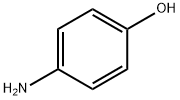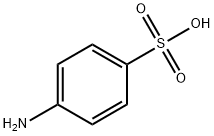p-Aminophenol , 98% , 123-30-8
Synonym(s):
4-Aminophenol;4-Hydroxyaniline
CAS NO.:123-30-8
Empirical Formula: C6H7NO
Molecular Weight: 109.13
MDL number: MFCD00007869
EINECS: 204-616-2
PRODUCT Properties
| Melting point: | 188 °C |
| Boiling point: | 284 °C |
| Density | 1.29 |
| vapor pressure | 0.4 hPa (110 °C) |
| refractive index | 1.5444 (estimate) |
| Flash point: | 189 °C |
| storage temp. | 2-8°C |
| solubility | water: slightly soluble |
| form | Crystalline Powder |
| pka | 5.48, 10.30(at 25℃) |
| color | White to cream |
| Water Solubility | 1.5 g/100 mL (20 ºC) |
| Sensitive | Air & Light Sensitive |
| Decomposition | 284 °C |
| Merck | 14,462 |
| BRN | 385836 |
| Stability: | Stable, though may discolour in air. Incompatible with acids, chloroformates, strong oxidizing agents. |
| InChIKey | PLIKAWJENQZMHA-UHFFFAOYSA-N |
| LogP | -0.09-0.04 at 25℃ |
| CAS DataBase Reference | 123-30-8(CAS DataBase Reference) |
| NIST Chemistry Reference | Phenol, 4-amino-(123-30-8) |
| EPA Substance Registry System | p-Aminophenol (123-30-8) |
Description and Uses
4-Aminophenol, also known as 4-hydroxyaniline, is an organic building block. Its quantification in water samples upto the detection limit of 8×10-10mol l-1 has been proposed by employing single-wall carbon nanotubes (SWNT)-nafion film coated glassy carbon electrodes. It is present as the main contaminant in pharmaceutical formulations of paracetamol. High-performance liquid chromatographic (HPLC) method with amperometric detection has been reported for its determination in various analgesic formulations. It has been reported to be formed from the reduction of 4-nitrophenol (Nip) under metal-free conditions catalyzed by N-doped graphene (NG).
4-Aminophenol is suitable for use in the synthesis of 2,2-bis(4-aminophenoxy) benzonitrile [4-APBN], a monomer required for the preparation of series of polyamides and poly(amide-imide)s. It may be used as derivatization reagent to improve the ionization of aliphatic and aromatic aldehydes by paper spray ionization mass spectrometry.
Safety
| Symbol(GHS) |    GHS07,GHS08,GHS09 |
| Signal word | Warning |
| Hazard statements | H302+H332-H317-H341-H373-H410 |
| Precautionary statements | P273-P280-P301+P312-P302+P352-P304+P340+P312-P308+P313 |
| Hazard Codes | Xn,N |
| Risk Statements | 20/22-50/53-68-40-R68-R50/53-R20/22 |
| Safety Statements | 28-36/37-60-61-28A-S61-S60-S36/37-S28A |
| RIDADR | UN 2512 6.1/PG 3 |
| WGK Germany | 3 |
| RTECS | SJ5075000 |
| F | 8 |
| Autoignition Temperature | >250 °C |
| TSCA | Yes |
| HazardClass | 6.1 |
| PackingGroup | III |
| HS Code | 28402090 |
| HS Code | 29222900 |
| Hazardous Substances Data | 123-30-8(Hazardous Substances Data) |
| Toxicity | LD50 orally in Rabbit: 375 mg/kg LD50 dermal Rabbit > 10000 mg/kg |



